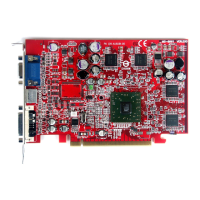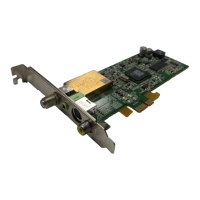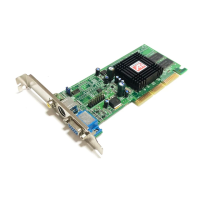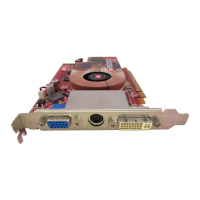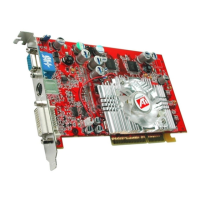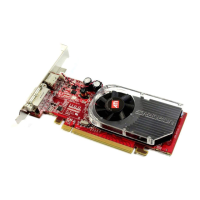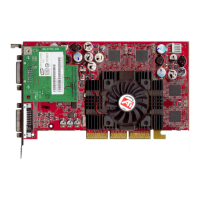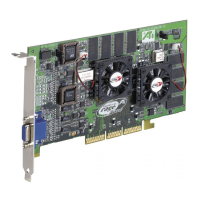Do you have a question about the ATI Technologies HD3800 Series and is the answer not in the manual?
Details hardware, OS, and monitor requirements for the graphics card.
Explains the performance enhancements and capabilities of the graphics accelerator.
Describes compatibility with DOS, VGA, and other software standards.
Outlines compatibility with various monitor types and refresh rates.
Lists the items included in the graphics card package for installation.
Step-by-step instructions for physically installing the graphics card into the computer.
Identifies connectors and key components on the graphics card's board.
Specifies the necessary power supply wattage and connections for the card.
Guides on setting up and configuring multiple displays with the graphics card.
Details various ways to connect displays, including CRT, DFP, and HDTV.
Instructions for removing existing graphics drivers to prevent conflicts.
Step-by-step guide for installing the graphics card drivers in Windows XP.
Step-by-step guide for installing the graphics card drivers in Windows Vista.
Introduces the Displays Manager for configuring display devices and desktop setup.
Explains how to use the Standard View for basic display settings and configuration.
Details advanced options for configuring display resolution, refresh rate, and arrangement.
Provides options to optimize OpenGL and Direct3D performance and manage display detection.
Guides on connecting and configuring TV-out functionality for viewing on TVs.
Instructions for using High Definition Television (HDTV) output and settings.
Explains how to adjust gamma, brightness, and contrast for the desktop color.
Details how to use ATI Overdrive to maximize graphics processing unit performance.
Guide for setting up HDMI audio and video output and changing default audio devices.
Lists generic classification, bus type, and video connectors for the graphics card.
Information on VGA modes and BIOS configuration for graphics programming.
Provides tables for supported resolutions, color depths, and frame buffer sizes.
Details hardware, OS, and monitor requirements for the graphics card.
Explains the performance enhancements and capabilities of the graphics accelerator.
Describes compatibility with DOS, VGA, and other software standards.
Outlines compatibility with various monitor types and refresh rates.
Lists the items included in the graphics card package for installation.
Step-by-step instructions for physically installing the graphics card into the computer.
Identifies connectors and key components on the graphics card's board.
Specifies the necessary power supply wattage and connections for the card.
Guides on setting up and configuring multiple displays with the graphics card.
Details various ways to connect displays, including CRT, DFP, and HDTV.
Instructions for removing existing graphics drivers to prevent conflicts.
Step-by-step guide for installing the graphics card drivers in Windows XP.
Step-by-step guide for installing the graphics card drivers in Windows Vista.
Introduces the Displays Manager for configuring display devices and desktop setup.
Explains how to use the Standard View for basic display settings and configuration.
Details advanced options for configuring display resolution, refresh rate, and arrangement.
Provides options to optimize OpenGL and Direct3D performance and manage display detection.
Guides on connecting and configuring TV-out functionality for viewing on TVs.
Instructions for using High Definition Television (HDTV) output and settings.
Explains how to adjust gamma, brightness, and contrast for the desktop color.
Details how to use ATI Overdrive to maximize graphics processing unit performance.
Guide for setting up HDMI audio and video output and changing default audio devices.
Lists generic classification, bus type, and video connectors for the graphics card.
Information on VGA modes and BIOS configuration for graphics programming.
Provides tables for supported resolutions, color depths, and frame buffer sizes.
| GPU | RV670 |
|---|---|
| Process Technology | 55 nm |
| DirectX Support | 10.1 |
| Shader Model | 4.1 |
| Memory Type | GDDR3 / GDDR4 |
| Memory Size | 512 MB / 1 GB |
| Memory Interface | 256-bit |
| Stream Processors | 320 |
| TMUs | 16 |
| ROPs | 16 |
| Interface | PCI Express 2.0 |
| CrossFire Support | Yes |
| Core Clock Speed | 668 - 825 MHz |
| Power Consumption | Varies by model |
| Power Connectors | 1x 6-pin or 2x 6-pin (varies by model) |
| Max Power Consumption | ~150W |
